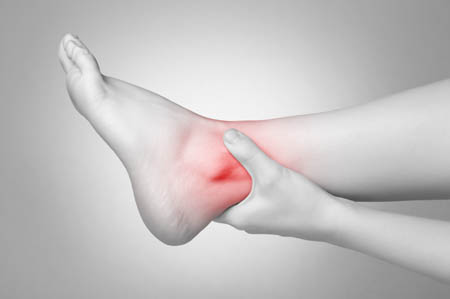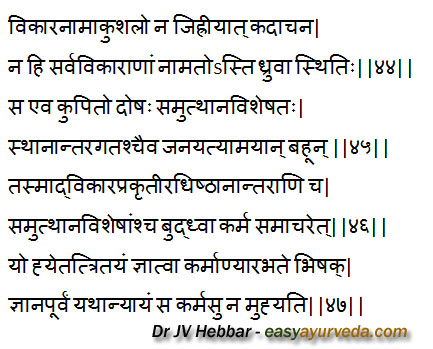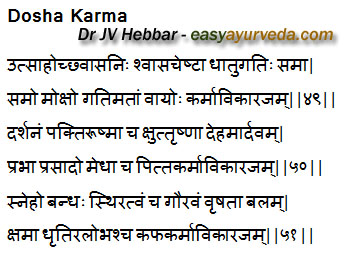Inflammation or swelling is of three types as per Ayurveda. In Ayurvedic terms, swelling is called Shotha or Shopha. Charaka has explained it in the 18th chapter of Sutrasthana, called Tri-Shotheeya Adhyaya. Apart from explanation of different types of inflammation, this chapter also explains normal functions of Vata, Pitta and Kapha Dosha, what to do when perfect diagnosis cannot be achieved, how diseases are innumerable etc.

Table of Contents
Classification of swellings
Swellings are of three types viz:
Vatika or Vataja – arising due to Vata Dosha imbalance.
Paittika or Pittaja – arising due to Pitta Dosha imbalance.
Shlaishmika or Kaphaja – arising due to Kapha Dosha imbalance.
They are again of two types-
Nija – Due to internal causes within the body, due to endogenous factors.
Agantuja – Due to external causes, such as injury. Due to exogenous factors. [3]
Causes of Exogenous Swellings
Causes – Aetiology of exogenous swellings- Agantu Shotha Nidana:
Chedana – excision wounds
Bhedana – incision wounds
Kshanana – comminuting
Bhanjana – fracture,
Picchana – exposure to excessive pressure
Utpeshana – grinding
Prahara – assault
Vadha – grievous hurt
Bandhana – tight tying
Veshtana – twisting by a snake, tight wrapping etc.
Vyadhana – piercing,
Peedana – compression, squeezing.
Contact of the fruit and flower of Bhallataka (Marking nut – Semecarpus anacardium Linn), Atmagupta (Mucuna prurita Hook), bristles of poisonous insects, harmful leaves, creepers and shrubs, sweat, crawling or urine of poisonous creatures, injury by fangs, teeth, horns, nails etc. of poisonous animals and coming in contact with the sea, poisonous wind, snow and fire.[4]
Causes of Endogenous Swellings
Endogenous and exogenous swellings – Nija and Agantuja Shotha –
The exogenous swelling (Agantu Shotha) is diagnosed by the characteristic etiology, signs and symptoms. Even though, ultimately the exogenous swelling may share the characteristic signs and symptoms of endogenous swelling, the difference lies in the priority or certain features common to both types of swellings.
The endogenous swelling (Nija Shotha) starts with the vitiation of Doshas and then brings about pain. The exogenous swelling, on the other hand, starts with pain and then brings about the vitiation of Doshas. This type of swellings are cured when treated with such therapies as bandages including
Bandha – talisman, bandaging
Mantra – incantations,
Agada – administration of medicines, antidotes
Pralepa – application of ointments,
Taapa – fomentation and
Nirvapa – cold sponging. [5]
Aetiology of Endogenous Swellings
Aetiology of endogenous swellings – Nija Shotha Nidana:
Endogenous swellings are caused by
Improper administration of oleation (Snehana), fomentation (Swedana), emesis (Vamana), purgation (Virechana), Asthapana and Anuvasana types of enema, elimination of Doshas from the head.
Adoption of improper post- Panchakarma dietetic program (Samsarjana Karma),
Excessive emaciation due to
Chardi – vomiting
Alasaka – intestinal torpor
Visuchika – Choleric diarrhea
Shwasa – dyspnoea,
Kasa – coughing,
Atisara – diarrhea,
Shosha – emaciation,
Pandu – anemia,
Udara – abdominal diseases
Jwara – fever
Pradara – menorrhagia,
Bhagandhara – fistula in ano
Arsha – piles
Kushta – skin diseases,
Kandu – pruritis
Vidhradi – abscess
Vega Dharana – suppression of natural urges.
When a person is emaciated due to Panchakarma Therapy / due to chronic disease / due to fasting or walking long distance, suddenly starts consuming exceedingly heavy, sour and salty food , pastry, fruits pickles, salad, alcohol, immature curd, germinated and fresh corn with or without bristles, meat of marshy or aquatic animals.
Intake of earth, mud, cold of earth, excessive intake of salt, pressure on gravid uterus, abortion, adoption of improper regimen after delivery and excitation of Doshas. These are the etiological factors for endogenous swelling (Ninja Shopha) [6]
Vataja Shopha clinical features
By the intake of cold, unctuous light and non-slimy food, exertion (Shrama), fasting (Upavasa), excessive emaciation and elimination therapy, the Vata gets aggravated and afflicts the Tvak (Skin), Mamsa (flesh) Rakta (blood) etc and causes swellings.
The swellings thus caused may appear and disappear abruptly.
They are either of blue or reddish colour or of the natural colour of the organ affected.
They are mobile and they throb.
Khara, Parusha, Bhinna Twak Roma – The skin and hair over the swellings are rough, hard and broken.
The pain due to swelling resemble,
Chidyata Iva – cutting,
Bhidhata iva – splitting,
Peedyata iva – pressing,
Soochibhiriva Tudyate – pinching by needles,
Pipeelika sarpana – crawling by ants, etc.
There is a tingling sensation as if covered with mustard paste. They contract and expand.
Pittaja Shotha clinical features
By the intake of hot, pungent, bitter, alkaline, saline, sour and heavy food and exposure to heat of fire and sun, the Pitta gets aggravated and affects the Tvak(Skin), Mamsa (flesh) and Rakta(Blood) and thus swelling is caused. It appears and disappears abruptly, it is black, yellow, blue and coppery in colour. It is hot and soft in touch, the hair over the swelling becomes light grey and coppery. There is a feeling of hot sensation, pain, emission of smoke, high temperature, steaming and sloughing. It does not stand hot.
Kaphaja Shopha clinical features
Due to the intake of heavy, sweet, cold and unctuous diet, excessive sleep, lack of exercise etc. the Kapha gets aggravated and it affects the skin, muscles, blood etc. to cause Shlaishmika type of swellings. Such swellings take a long time to manifest themselves and cure. They are of apparently pale white colour, heavy, unctuous, smooth, immobile, compact and having white hair in the border. They stand pressure and heat.
According to the aetiology, signs and symptoms, there are three more types of swellings due to the combined morbidity of two Doshas (viz Vata-Pittaja, Vata-Kaphaja and Pitta-Kaphaja).
There is only one Sannipatika type of swelling arising out of the combined morbidity of all the three Doshas and it manifests the signs and symptoms of all the three Doshas.
Thus there are seven varieties of swelling caused by the vitiation of Doshas.
Based on the above explanations, Shotha can be classified as of two types :
- exogenous
- endogenous
Or of three types (Vatika, Paittika and Shlaismika),
Or of four types (Vatika, Pattika and Shlaismika and exogenous variety),
Seven types (Vatika, pattitika, Shlaismika, Vata-Pittaja, Kapha-Pittaja, Vata-Kaphaja and Sannipatika) and eight types (seven types of endogenous and one type of exogenous).
But on an ultimate analysis, Shotha is only of one type having the swelling as a characteristic sign in common.[7-8]
Vataja Shotha is characterized by swelling, numbness and pain in the limbs and it regains its normal position immediately after it is pressed (and the pressure is withdrawn). The swelling which is reddish in colour, disappears during the night and gets cured by the application of unctuous during the night and gets cured by the application of unctuous and hot massage is also of Vatika type.
In Pittaja Shotha the patient feels thirsty and feverish, there is pain and burning sensation in the swelling, there is sweating, sloughing and foul smell, the eyes, face and middle part of the body, the skin becomes thin and there is diarrhoea.
The Kaphaja Shotha is cold in touch, it does not spread, it causes itching. It is pale in colour and it pits on pressure. Moreover, the Slaismika type of swelling does not bleed even if it is cut with a weapon or sharp edged grass, there is oozing after a long time.
The swellings due to the combination of two doshas may be diagnosed on the basis of the combined aetiology, signs and symptoms. Similarly, the Sannipatika type (due to vitiation of all three Doshas) of swelling can also be diagnosed from the combination of etiological factors. [9-15]
Yogas for Sopha From Sahasra Yoga Text Book
Sophahara Kashaya
Koushikokta Rasnadi Kwatha
Panduhara Kashaya
Tiktaka Ghrita
Mahatiktaka Ghrita
Sukumara Ghrita
Kusmanda Ghrita
Khandasama Choorna
Trikatwadi choorna
Hapushadi choorna
Hutabhungadi Choorna
Ayorajo Nagaradi Choorna
Krishna Rajanyadi Choorna
Triphaladi Talam
Kalyana Kshara
Dantyarishta
Duralabharishta
Punarnavasava
Usirasava
Lohasava
Patrangasava
Kumaryasava
Danti Haritakyavaleha
Punarnavadi Lehya
Dasamoola Haritaki Lehya
Gudardraka
Trivrit Kulambu
Kaisora Guggulu
Amruta Guggulu
Mandoora Vataka
Chanda Bhaskara Rasa
Neelakantha Rasa
Marichadi Gutika
Antrakutara Rasa
Panalviraladi Bhasma Ganji
Aviltoladi Bhasma Ganji
Swasari Taila
Karaskara Ghrita
Dasamooladi Kashaya
Chukkuchundadi Kashaya
Pathyapunarnvadi Kashaya
Guduchi Triphaladi Kashaya
Prognosis of Shotha Roga
In case of male patients, if the swelling starts from the feet and spreads all over the body, and in case of female patients if it starts from the mouth (head) and spreads, it is difficult to cure. In both male and female patients if the swelling starts from the perineum and is associated with complications, it is exceedingly difficult to cure. [16-17]
Complications of Shotha roga
The seven complications of Shotha Roga are:
Chardi – vomiting
Shwasa – dyspnoea,
Aruchi – anorexia,
Trushna – thirst,
Jvara – fever,
Atisara – diarrhoea
Daurbalya – general weakness. [18]
Localized inflammatory conditions
If the aggravated Kapha is located at the root of the tongue, it causes instantaneous swelling which is known as Upajihvika. When the aggravated Kapha is located in the root of the palate, it causes instantaneous swelling, this is known as Galashundika. If the aggravated Kapha is located outside the throat it causes swelling. This is known as Galaganda. (compared with cervical lymphadenitis, goitre etc).
- When the aggravated Pitta together with Rakta spreads within the skin, it causes red swelling which is known as Visarpa. (compared with herpes)
- When the aggravated Pitta is located in the Tvak (skin) and Vata, this will also cause red swelling which is known as Pidaka (carbuncle / abscess).
- When the aggravated Pitta gets dried up in combination with Rakta, this causes skin diseases like Tilaka (black moles), Piplu (port wine mark), Vyanga (red moles) and Neelika (blue moles).
- When aggravated in both the temples, the Pitta causes a serious type of swelling there known as Shankhaka.
- When the aggravated Pitta localizes in the root of the ears specially after fever, it causes swelling which is difficult to cure and may lead to death.
- When the aggravated Vata disturbs the spleen and causes pain in the sides of the abdomen, it leads to the enlargement of the spleen.
- When the aggravated Vata is localised in the abdomen this causes swelling together with pain three resulting in the formation of Gulma (tumour / fibroid) there.
- When the aggravated Vata moves from the sides of the lower abdomen to testicles and three by causes swelling and pain there, it is known as Vruddhi (hernia / hydrocele)
- When the aggravated vata is localized in the abdomen but does neither move downwards nor upwards this is known as Udararoga. (Ascites).
- When the aggravated Vata is localized within the skin and muscles (in the intestines), it causes swelling in the abdomen. This is known as Anaha (constipation).
Besides such swelling as Adhimamsa, Arrbuda etc. though having distinctive features of their own both by their name and form, they are all to be included under Shotha because swelling is the common feature.
When Vata, Pitta and Kapha- all the three Doshas in morbid condition, are simultaneously aggravated and they are localized in the root of the tongue causing burning sensation and swelling, this results in swelling all the more and causes various types of pain. This acute disease is known as Rohini. The patient suffering from this disease can hardly survive for three nights. If however, he is quickly treated by a skilled physician, he can be cured.[19-36]
Progress of diseases in general
There are diseases of serious type which even though curable with difficulties can cause death if not properly treated or treated wrongly. There are other diseases of mild nature which are definitely cured by treatment with or without any special care. There is another category of palliable diseases which are not curable but even the most effective treatment will only enable the patient to stand the disease. There are other diseases where no treatment can succeed. Only ignorant physicians will attempt to treat such cases, wise physicians will not.
Types of diseases based on curability
Diseases are of two types-
Sadhya – curable
Asadhya – incurable.
Each of them is again of two types viz. mild (Mrudu) or serious (Daruna). Thus, taken together, there are four types of diseases.[37-41].
Innumerable diseases
In fact diseases are of innumerable varieties depending upon their distinctive features like pain, colour (signs), aetiology, site of origin and manifestation (like abdomen, Rasadatu etc.), symptoms (like Gulma or tumour etc) and nomenclature (like Rajayaksma, Shosha etc). Only important diseases have, however, been enumerated(in Sutrasthana 19th chapter). Other diseases are classified similarly according to the factors involved in their manifestation.[42-43]

Correct approach to the diagnosis and treatment
If a physician is not able to name a particular disease, he should not feel ashamed on that account because it is not always possible to name all types of diseases in definite terms. When aggravated, a single Dosha may cause manifold diseases depending upon the various etiological factors and the sites of manifestation.
So a physician should try to comprehend the nature of the disease based on Dosha, the site of its manifestation and etiological factors and should then initiate the treatment, A physician who so initiates the treatment after having full knowledge of the therapeutic properties of these three aspects and paying due regard to scriptural instructions would never fail in his attempt to cure the disease.[44-47]
Relation of Doshas with body
The three Doshas, viz. Vata, Pitta and Kapha are already present in the body of all creatures. A physician should try to know whether they are in normal or morbid condition.[48]

Functions of normal Doshas
Normal Functions of Vata Dosha –
When Vata is in its normal state, it reflects itself in the form of
Utsaha – enthusiasm,
Uchvasa – inspiration,
Nishvasa – expiration,
Cheshta – movements,
Vega Pravartana – expression of natural urges – like urination, etc.
Normal metabolic transformation of tissues and proper elimination of excreta.
Normal functions of Pitta Dosha –
Darshana – good vision,
Pakti – good digestion,
Ushma – normal temperature,
Kshut – normal hunger,
Trushna – thirst,
Mardava – bodily softness,
Prabha – lustre,
Prasaada – happiness and
Medha – intelligence.
Normal functions of Kapha Dosha –
Effects of Kapha in its normal state are
Sneha – unctuousness, oiliness,
Bandha – cohesion, compactness,
Sthiratva – steadiness,
Gaurava – heaviness,
Vrushata – virility,
Bala – strength,
Kshama – forbearance,
Dhruti – patience, good memory and retention power
Alobha – lack of greed [49-51]
Functions of Abnormal Doshas
The diminution of Vata, Pitta and Kapha is indicated by the decrease in their respective normal actions or increase in their respective opposite actions.[52]
The aggravation of Doshas is invariably indicated by something in excess of their respective normal action. Thus, one can examine the normal condition deficiency or aggravation of Doshas as the case may be. [53]
Summary
Lord Punarvasu who is free from attachment, Rajas, greed, ego, pride and desire has explained in this chapter on ”The three types of swellings”. The following types: aetiology, signs and symptoms, curability or otherwise of swellings, the swelling that appear as premonitory signs of various diseases, different types of diseases, the important points which are to be kept in view during treatment, the normal functions of Doshas and signs and symptoms of diminished or aggravated Doshas.[54-56]
Thus ends the Eighteenth chapter on “The Three Types of Swelling” of the Sutrasthana of Agnivesha’s work as redacted by Charaka.











4 comments
Anshu
Sir is inguinal hernia curable using ayurvedic medicines? please mention I need immediate help. And if you please wish to mention some remedial methods and medicines, I will be very greatful.
Regards.
Dr J V Hebbar MD(Ayu)Author
No.
Bhaskar Bandaru
Respected Sir,
Is there Permanent Cure for HEMOPHILIA in AyurvedA ?
Dr J V Hebbar MD(Ayu)Author
I do not know of a permanent cure.